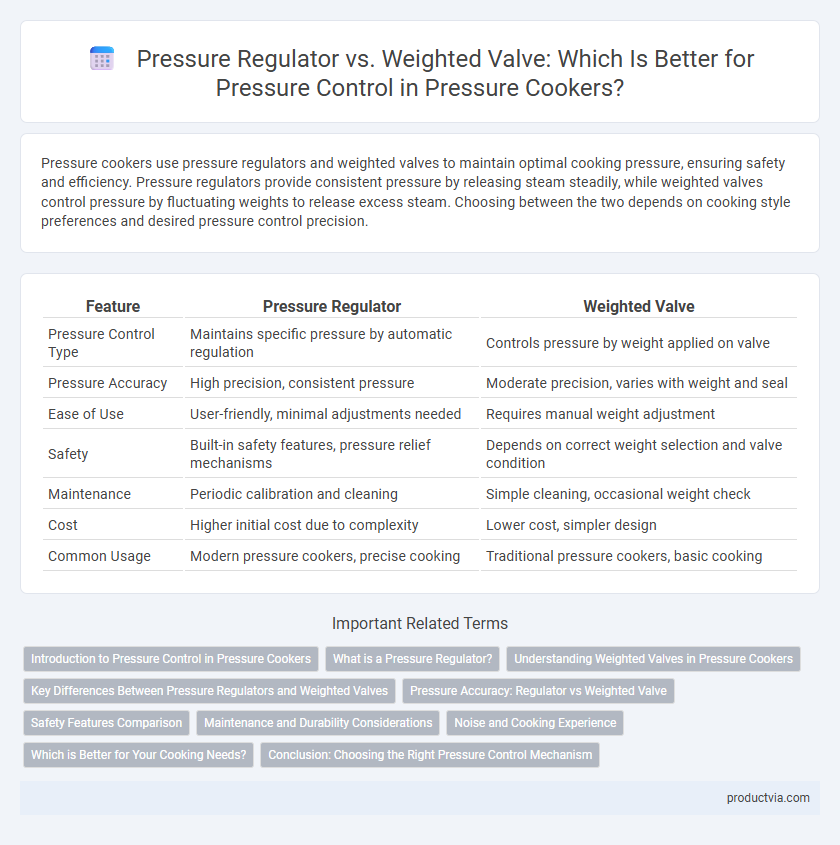Pressure cookers use pressure regulators and weighted valves to maintain optimal cooking pressure, ensuring safety and efficiency. Pressure regulators provide consistent pressure by releasing steam steadily, while weighted valves control pressure by fluctuating weights to release excess steam. Choosing between the two depends on cooking style preferences and desired pressure control precision.
Table of Comparison
| Feature | Pressure Regulator | Weighted Valve |
|---|---|---|
| Pressure Control Type | Maintains specific pressure by automatic regulation | Controls pressure by weight applied on valve |
| Pressure Accuracy | High precision, consistent pressure | Moderate precision, varies with weight and seal |
| Ease of Use | User-friendly, minimal adjustments needed | Requires manual weight adjustment |
| Safety | Built-in safety features, pressure relief mechanisms | Depends on correct weight selection and valve condition |
| Maintenance | Periodic calibration and cleaning | Simple cleaning, occasional weight check |
| Cost | Higher initial cost due to complexity | Lower cost, simpler design |
| Common Usage | Modern pressure cookers, precise cooking | Traditional pressure cookers, basic cooking |
Introduction to Pressure Control in Pressure Cookers
Pressure cookers use pressure control mechanisms like pressure regulators and weighted valves to maintain optimal cooking pressure and ensure safety. Pressure regulators provide precise control by releasing steam at a set pressure, while weighted valves function by balancing weight to regulate steam release. Understanding these components helps optimize cooking efficiency and prevent over-pressurization.
What is a Pressure Regulator?
A pressure regulator is a device designed to maintain a consistent pressure level within a pressure cooker by automatically adjusting the flow of steam released. It ensures safe cooking by preventing excessive pressure buildup, which can lead to cooker malfunctions or accidents. Unlike weighted valves that rely on physical weights to release steam, pressure regulators use precise mechanisms to control pressure more accurately and efficiently.
Understanding Weighted Valves in Pressure Cookers
Weighted valves in pressure cookers regulate internal pressure by releasing steam when it reaches a predetermined level, ensuring consistent cooking conditions. These valves are designed with a specific weight that balances pressure and safety, making them reliable for maintaining optimal cooking pressure without complex adjustments. Compared to pressure regulators, weighted valves offer straightforward operation and durable performance, making them a popular choice for home and commercial pressure cookers.
Key Differences Between Pressure Regulators and Weighted Valves
Pressure regulators maintain a consistent internal pressure by automatically adjusting the steam release through a spring-loaded mechanism, ensuring precise control during cooking. Weighted valves utilize a simple mass-based system where the valve's weight determines steam pressure by lifting off the vent pipe at a set pressure level. Key differences include pressure regulators offering finer pressure adjustment and stability, while weighted valves provide straightforward, mechanical pressure control with less precision.
Pressure Accuracy: Regulator vs Weighted Valve
Pressure regulators provide precise pressure control through a spring-loaded mechanism, maintaining consistent internal pressure by automatically adjusting the steam release based on preset levels. Weighted valves rely on gravity and weight variations to control pressure, resulting in less accurate pressure maintenance due to fluctuations in weight and steam output. For applications demanding high pressure accuracy, regulators outperform weighted valves by delivering stable and consistent pressure control.
Safety Features Comparison
Pressure regulators in pressure cookers offer precise pressure control through a spring-loaded mechanism, providing consistent pressure release to prevent excessive build-up and ensure user safety. Weighted valves rely on gravity to maintain pressure by allowing steam to escape at a predetermined pressure, which can be less precise but simpler to operate and maintain. Safety features of pressure regulators include automatic pressure adjustment and enhanced durability against pressure fluctuations, while weighted valves provide a straightforward visual indication of pressure status but may require more vigilant monitoring to avoid safety risks.
Maintenance and Durability Considerations
Pressure regulators in pressure cookers require regular inspection and occasional replacement of rubber gaskets to maintain airtight seals, while weighted valves demand minimal maintenance due to their simple design and fewer movable parts. Durable materials such as stainless steel used in weighted valves enhance longevity and resist corrosion better than some pressure regulators, which may degrade faster under frequent use. Proper maintenance of both components extends the lifespan of the pressure cooker, with weighted valves generally offering superior durability in high-use environments.
Noise and Cooking Experience
Pressure regulators provide precise pressure control with minimal noise, enhancing the cooking experience by maintaining steady steam release. Weighted valves tend to generate more noise due to their fluctuating pressure release but offer traditional, manual adjustments favored by some cooks. Choosing between them depends on whether a quieter environment or hands-on pressure control is preferred during cooking.
Which is Better for Your Cooking Needs?
Pressure regulators provide precise control by maintaining consistent pressure levels, ideal for recipes requiring exact cooking times and textures. Weighted valves, common in traditional stovetop pressure cookers, allow pressure to fluctuate slightly, offering a more forgiving cooking style suitable for stews and tougher cuts of meat. Choosing between a pressure regulator and a weighted valve depends on your cooking preferences: opt for a pressure regulator for accuracy, or a weighted valve for simplicity and versatility.
Conclusion: Choosing the Right Pressure Control Mechanism
Selecting the appropriate pressure control mechanism between a pressure regulator and a weighted valve depends on the desired cooking precision and ease of use. Pressure regulators offer consistent pressure maintenance suited for delicate recipes, while weighted valves provide a more traditional, manual approach favored for their simplicity and durability. Understanding specific cooking requirements and maintenance preferences is essential for optimal pressure cooker performance.
Pressure regulator vs Weighted valve for pressure control Infographic

 productvia.com
productvia.com